Types Of Jwara According To Ayurveda: Jwara Bheda
By Dr Raghuram Y.S. MD (Ay) & Dr Manasa, B.A.M.S
Ayurveda has explained many types of fevers in the chapters dealing with ‘jwara’. Even in modern day we can see newer types of fevers manifesting every now and then. Fever may be a disease or a symptom of many diseases or even may manifest as a complication. Treating fevers may be easy at times and hard at many times. Here we have enlisted types of fever as explained in Ayurveda treatises, with special reference to Charaka Samhita.
Read – Ayurveda Lifestyle and Diet For Fever – 45 Important Things To Know
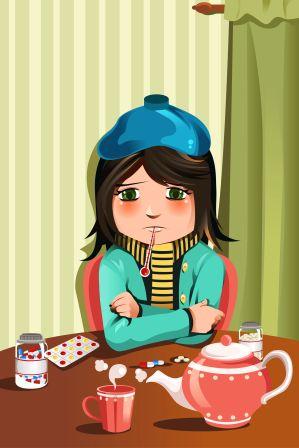
Table of Contents
Types of Fever in Ayurveda – Jwara bheda
A. Classification based on dual presentation (vidhi bheda)
1. Sharirika Jwara and Manasika Jwara
Sharirika Jwara fever which manifests at the physical level. Master Charaka says that this type of fever first manifests at the physical level. This also means that this fever may, in later period of time afflict the mind also. Manasika Jwara means fever which manifests at the mental level. Master Charaka says that this type of fever first manifests at the mental level and later afflict the body also. In both cases, the body and mind will be afflicted.
Read – Charaka – Jwara Chikitsa 3rd Chapter
2. Soumya Jwara and Agneya Jwara
Sowmya Jwara – Sowmya means cold or milder. Fevers which manifest due to aggravated vata and kapha, the patient desire towards hot or warm comforts, including foods and activities.
Agneya Jwara – Agneya means hot or fiery. Fevers which manifest due to aggravated vata and pitta, the patient show desire towards cold, including foods and activities.
Read – Causes, Symptoms, Treatment Of Recurring Fevers Punaravartaka Jwara
3. Antarvega Jwara and Bahirvega Jwara
Antarvega Jwara means fever in which the symptoms are manifested internally and temperature cannot be felt. Symptoms of this fever include –
- Antardaha – burning sensation inside the body
- Adhika trshna – excessive thirst
- Pralapa – delirium
- Shvasanam – difficulty in breathing / dyspnea
- Bhramah – giddiness / vertigo
- Sandhi shula – pain in the joints
- Asthi shula – pain in the bones
- Asveda – lack / absence of sweating
- Dosha vinigraha – obstruction of doshas in the body
- Varcha vinigraha – constipation
Bahirvega Jwara means fever in which the symptoms are manifested externally and temperature can be felt. Symptoms of this fever include –
- Santapo adhiko bahyah – excessive temperature felt on the surface of the body
- Trushnadinam cha mardavam – mildness of thirst etc symptoms mentioned in antarvega jwara
From prognosis point of view, bahirvega jwara is said to be easily curable whereas antarvega jwara is difficult to cure.
Read – Jwara Pravritti – The Initial Manifestation
4. Prakruta Jwara and Vaikruta Jwara
Prakruta Jwara – Kapha and Pitta predominant fevers which manifest in their related seasons of aggravation are called prakruta jwara. Thus, Kapha fever occurring in spring season (season, natural for kapha aggravation) and Pitta fever occurring in autumn season (season, natural for pitta aggravation) are prakruta jwara.
Vaikruta Jwara – Kapha and Pitta fevers manifesting in seasons other than those naturally meant for their aggravation are called as Vaikruta Jwara. Example – Kapha fever occurring in summer or Pitta fever occurring in rainy season.
On contrary, vata fever occurring in its natural season of aggravation i.e. rainy season is incurable due to opposite treatments which need to be implemented. Therefore, this case is an exception and vata fever occurring in monsoon can never be considered as prakruta jwara.
Read – Diet and Ayurveda Home Remedy For Fever And Cold
5. Sadhya Jwara and Asadhya Jwara
Sadhya Jwara – means those fevers which are easily curable. Below mentioned are the conditions for a fever to be curable –
- strength of the patient is good
- dosha aggravation is feeble
- fever associated with complications
Asadhya Jwara – fevers which are not curable. Below mentioned are the conditions for a fever to be incurable –
- fever manifested from powerful etiological factors
- fever manifesting with many or all symptoms
- fever which quickly destroy the strength of sense organs and perception
These fevers are said to cause death in quick time.
Read – How To Make Prognosis Of Disease According To Ayurveda?
B. Classification based on strength and weakness of time of aggravation of dosha (dosha kala bala-abala bheda)
Based on periodicity of manifestation of fever and the strength and weakness of doshas in relation to time of aggravation of dosha and time of manifestation of fevers, the fevers are once again classified into five types. They are called as Vishama Jwaras. They are –
- Santata Jwara
- Satata Jwara
- Anyedhyushka Jwara
- Trtiyaka Jwara
- Chaturthika Jwara
Read – Vishama Jwara Definition, Causes, Types, Symptoms, Treatment
C. Classification based on the tissues in which the fever is located (dhatugata jwara)
- Rasa dhatugata jwara – fever located in rasa tissue
- Rakta dhatugata jwara – fever located in the blood tissue
- Mamsa dhatugata jwara – fever located in muscle tissue
- Medo dhatugata jwara – fever located in fat tissue
- Asthi dhatugata jwara – fever located in bone tissue
- Majja dhatugata jwara – fever located in bone-marrow tissue
- Shukra dhatugata jwara – fever located in semen tissue
Read – Dhatugata Jwara Fever Seated In The Tissues
D. Classification based on the causes of fever (karana bheda)
Master Charaka mentioned this classification of fevers in the Nidana Sthana section wherein he had described the causative factors and symptoms in brief of the 8 kinds of fevers. This is the reason that Master Charaka has touched upon this classification at the end part, as the last type of classification of fever in Chikitsa Sthana section.
The 8 kinds of fever in this classification include –
- Vataja Jwara – caused due to aggravation of vata
- Pittaja Jwara – caused due to aggravation of pitta
- Kaphaja Jwara – caused due to aggravation of kapha
- Vata-Pittaja Jwara – caused due to aggravation of vata and pitta
- Vata-Shlaishmika / Vata-Kaphaja Jwara – caused due to aggravation of vata and kapha
- Shleshma-Paittika / Kapha-Pittaja Jwara – caused due to aggravation of kapha and pitta
- Sannipataja Jwara – caused due to simultaneous aggravation of all three doshas i.e. vata, pitta and kapha – This is once again classified into 13 types based on the permutation and combination of the vitiated doshas in the combination
- Agantuja Jwara – fever caused due to external factors – This fever is again said to be of 4 types – abhighataja, abhishangaja, abhicharaja and abhishapaja
Read – Tridosha Theory in Ayurveda
Prakruta And Vaikruta Jwar
Prakruta Jwara and Vaikruta Jwara are two types of fevers mentioned by Master Charaka in the context of classification of fevers in Charaka Samhita Chikitsa Sthana section, Chapter 3, dealing with ‘Jwara Chikitsa – treatment of fevers’. By meaning –
- Prakruta means normal
- Vaikruta means abnormal
In this sense prakruta jwara means normal fevers and vaikruta jwara means abnormal fevers. This doesn’t give any sense isn’t it? No fever is normal. So what is the classical meaning of these fevers and what is the importance of knowing them from clinical perspective? Let us explore these fevers in this article.
Read – Charaka – Jwara Chikitsa 3rd Chapter
Prakruta Jwara and Vaikruta Jwara are explained in relation to the fevers manifesting in particular seasons. Therefore, Prakruta Jwara can be considered as fever manifesting in a season natural to the aggravation of particular dosha and Vaikruta Jwara is the fever manifesting in a season which is not natural for the aggravation of that particular dosha. So these fevers can be considered as ‘seasonal fevers – normal or abnormal to the related doshas’. Let us look into the classical explanation of these fevers to get clarity of understanding.
Read – Charaka Jwara Nidana: 1st Chapter
Classical explanation of prakruta and vaikruta jwara
Prakruta Jwara manifesting in Spring season and Autumn season are easily curable. Kapha aggravation takes place in spring season. Therefore, it is obvious that kapha predominant fever is manifested in this season. Kapha fever manifesting in this season is easily curable. Similarly, Pitta aggravation takes place in autumn season. Therefore, it is obvious that pitta predominant fever is manifested in this season. Pitta fever manifesting in this season is easily curable. Putting it the other way, spring is the natural season for kapha aggravation and autumn is the natural season for pitta aggravation. Therefore, kapha fever manifesting in spring season is prakruta kapha jvara. Similarly, pitta fever manifesting in autumn season is prakruta pitta jwara.
Why and how does pitta aggravate in the autumn season and cause prakruta pitta fever?Pitta is hot by nature. Accumulation of pitta in its own seats takes place in the monsoon season owing to the impact of that season on pitta. In the monsoon season the water and medicines and foods will have sour after taste owing to the impact of the season. This will lead to accumulation of pitta in its seats because sour taste aggravates pitta. In the next season i.e. in autumn season pitta would get aggravated owing to the heat prevalent in that season, which is favorable for its aggravation. Due to the intensity of heat in autumn season, pitta will undergo aggravation. This aggravated pitta will cause pitta type of fever when the pathogenesis is favorable for manifestation of fever. So, autumn season, for everyone, is natural for pitta aggravation and is universal phenomenon. In pitta type of fever there is association of kapha with pitta. Pitta aggravation gets its strength and support from kapha in causation of fever.
Upavasa – fasting is the preferred treatment for pitta fever occurring in autumn. Due to its nature and impact of visarga kala (milder seasons), pitta would tolerate the effect of fasting (pitta might aggravate if fasting is done in adana kala). Therefore, one need not fear to fast while suffering from prakruta pittaja fever.
Read – Role Of Fasting In The Treatment Of Fever – Langhana In Jwara
Why and how does kapha aggravate in the spring season and cause prakruta kapha fever?Kapha by nature is cold. Accumulation of kapha in its own seats takes place in the cold predominant season (hemanta / shishira rtu – early or late winter) owing to the impact of that season on kapha. In the winter season the water, medicines and foods will have sweet after taste owing to the impact of the season. This will lead to accumulation of kapha in its seats because sweet taste aggravates kapha. In the next season i.e. in the spring season, kapha melts due to the intense and sharp sun rays and eventually gets aggravated since this season is favorable for aggravation of kapha. This aggravated kapha will cause kapha type of fever when the pathogenesis is favorable for manifestation of fever.
So, spring season, for everyone, is natural for kapha aggravation and is universal phenomenon. In kapha type of fever there is association of pitta and vata with kapha. Kapha aggravation gets its strength and support from vata and pitta in causation of fever.
Sanskrit Verses
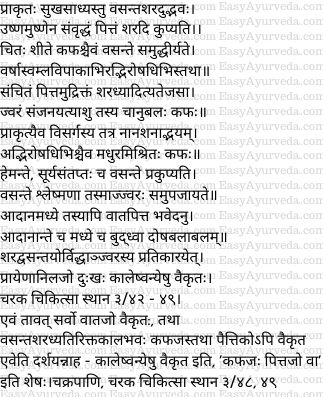
Treatment principle of Prakruta Jwara
A wise physician should treat the prakruta (pitta and kapha) fever in the beginning, middle or end part of autumn and spring seasons after having thoroughly accessed the strength and weakness of the doshas involved in the causation of these fevers (pitta and kapha).
Read – Ritucharya – Healthy Seasonal Regimen – Introduction, Divisions
Exceptions in the rules of Prakruta jwara
Manifestation of Prakruta Vata Jwara
Now we get a doubt so as to why vata type of jwara has not been mentioned in this context. Master Charaka has mentioned Vata fever at the end because the pattern of manifestation of this fever and the rules relating to the same are quite different from prakruta pitta and kapha fevers. We know that pitta and kapha getting aggravated in the seasons which are natural for their aggravation i.e. in autumn and spring seasons and causing pittaja and kaphaja fevers are easy to treat. But vata fevers do follow a different pattern. The season for aggravation of vata is monsoon season.
Vata gets accumulated in summer season due to the dryness of the season but will not undergo aggravation due to the heat prevailing in this season which is antagonist to the cold nature of vata. In the next season i.e. in the rainy season vata would get aggravated. This would cause vataja type of fever if the pathogenesis is favoring for the manifestation of fever. Coming to the prognosis of vataja jwara, unlike pittaja and kaphaja fevers, vata type of fevers manifesting in the season natural for its manifestation i.e. in the rainy season is difficult to cure. Therefore vataja fevers occurring in the season natural for them i.e. rainy season can never be prakruta.
Read – Dosha Chaya, Kopa, Shamana – Accumulation, Aggravation, Auto-pacification
Why is it difficult to cure vata fever manifesting in rainy season?
In spite of the kala prakruti (nature of the rainy season) being similar to the dosha (vata) causing fever, the vata type of fever caused in rainy season is difficult to cure because of viruddha upakrama i.e. opposite nature of the treatment. According to Ayurveda, the origin of fever is said to be from amashaya i.e. stomach. So, langhana mainly therapeutic starvation is the main treatment for diseases manifesting from amashaya. But this langhana is antagonistic to the nature of vata and tends to cause its aggravation. Thus, the initial treatment for fever and the seat of origin of fever is opposite to the treatment of vata. The treatment for vata which includes use of unctuous substances, sweet, sour and salty foods and nourishing therapies is opposite to the treatment of fever and diseases having their origin from stomach. This is called viruddha upakrama. Since it is difficult to treat vataja fever in rainy season it will not be considered as prakruta jvara.
Read – How To Balance Vata Dosha? Line Of Treatment And Reasoning
Vaikruta Jwara
All vataja fevers are vaikruta i.e. abnormal. Prakruta jwara is that fever which can be easily cured in the season favorable for the aggravation of dosha responsible for the causation of that fever and vataja fever, as explained above, doesn’t fulfil these criteria. Vataja fever occurring in rainy season is not prakruta, in fact it is vaikruta. Kaphaja fevers occurring in seasons other than spring season will be considered as vaikruta jwara.
Pittaja fevers occurring in seasons other than autumn season will be considered as vaikruta jwara. Thus, for kaphaja and pittaja fevers, it will be considered as vaikruta jwara or abnormal fevers if they manifest in seasons other than those in which their natural aggravation takes place i.e. spring and autumn seasons respectively. Other authors opine that vataja fever occurring in rainy season is also prakruta, but like kaphaja and pittaja fevers occurring in spring and autumn seasons, vataja fever occurring in rainy season is not easily curable. This also gives us a clue that prakruta and vaikruta types of fever have been explained from the perspective of easy curability of fevers in their respective seasons or otherwise.
Read – Shat Kriya Kala – ‘Stage-Wise Disease Management’
Purpose of knowing prakruta and vaikruta types of fever
The physician should have precise knowledge of prakruta and vaikruta jwaras. This will give an idea so as to in which season a particular dosha will undergo vitiation so as to cause fever and in which season a given fever is curable easily and in which season it cannot be easily cured. The backdrop of knowing these fevers is a precise knowledge of ‘relationship between doshas and seasonal changes’ i.e. rtu-kriyakala.
The knowledge of these fevers will help the physician to draft effective seasonal approach and seasonal remedies to combat these seasonal and off-seasonal fevers.
The knowledge of these fevers will also help the physician to understand the prognosis of these seasonal and off-seasonal fevers.
Agantuja Jwara
Agantuja Jwaras are those fevers which are caused by external factors. Agantuja Jwara is itself of four types. Agantuja means ‘those which come from outside’ or ‘foreign’, Jwara means fever.
Read – Ayurveda Lifestyle and Diet For Fever – 45 Important Things To Know

Types of Agantuja Jwara
Agantuja Jwara is of four types
- Abhighataja Jwara
- Abhishangaja Jwara
- Abhicharaja Jwara
- Abhishapaja Jwara
1. Abhighataja Jwara
Abhighata means injury or trauma.
Causes – Abhighataja Jwara is caused due to injury by one or more of the below mentioned –
- shastra – instrument / weapon
- loshta – mud ball
- kasha – whip
- kashta – stick / bamboo
- mushta – fist
- aratni tala – slap
- dvija – teeth etc
Pathogenesis
The vata aggravated due to injury predominantly vitiates the blood and causes abhighataja jwara. In this case blood is the tissue which gets predominantly vitiated. This means to tell that the other tissues too are vitiated but to a lesser extent in comparison to the blood.
Symptoms
- vyatha – discomfort
- shopha – swelling / inflammation
- vaivarnyam – discoloration
- ruja – pain
Read – Charaka Jwara Nidana: 1st Chapter
2. Abhishangaja Jwara
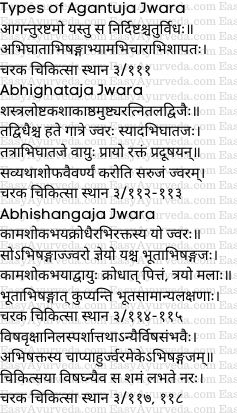
Abhishanga means curse. Abhishangaja Jwara is that which is supposed to be caused by affliction of evil spirits or by curse.
Causes – include being afflicted by
- kama – desire / lust
- shoka – grief
- bhaya – fear
- krodha – anger
- bhuta – evil spirits / unknown and unseen forces
The fevers will also be called by the name of these causes like kamaja jwara when caused by kama, shokaja jwara when caused by shoka etc. Among the above said causes, desire (lust), grief and fear would cause aggravation of vata. Anger would cause aggravation of pitta. Affliction of evil spirits would cause aggravation of all the three doshas.
In bhutabhishangaja jwara, the fever would manifest with the symptoms of the same evil spirit which would afflict the person. These are the same bhutas (spirits) which are mentioned in the context of unmada (psychosis) which cause the bhutabhishangaja type of fevers. They are –
- Deva graha
- Guru graha
- Pitr graha
- Gandharva graha
- Yaksha graha
- Rakshasa graha
- Brahma rakshasa graha
- Pishacha graha
The symptoms of the fever will be in accordance to the graha which would afflict the person.
Read – Dhatugata Jwara Fever Seated In The Tissues
Other causes of Abhishangaja Jwara
- Visha vrksha anila sparsha – when the breeze flowing through the poisonous plants and that air touches the body of the person
- Anyaih vishaih sambhavaih – when breeze flowing through any other poisonous substances touch the body of the person
This type of abhishangaja jwara caused by touch of poisonous air can be treated by administration of ‘anti-poisonous’ treatments and medicines.
Read – Charaka Visha Chikitsa 23rd Chapter of Chikitsa Sthana
Specific symptoms of abhishangaja jwara according to the cause –
| Sl No | Name of Agantuja Jwara | Symptoms |
| 1 | Kama Jwara | Dhyana – being thoughtful, lost in thoughts / worried Nishvasa bahulam – exacerbation in breathing / violent breathing patterns |
| 2 | Shoka janya jwara | Bashpa bahulam – discharge of excessive tears from the eyes |
| 3 | Bhaya janya jwara | Trasa prayam – feeling of excessive fear |
| 4 | Krodha janya jwara | Adhika samrambham – excessive redness in the eyes and in the face |
| 5 | Bhutavesha jwara / Bhutabhishangaja jwara | Amanusham – does inhuman activities (those activities which he wasn’t used to do earlier) |
| 6 | Vishajanya | Murcha (loss of consciousness), moha (confusion), mada (intoxication), glani (fatigue) in excess |
In these fevers, rise in temperature may be evidenced before or after the manifestation of above mentioned symptoms. When kama, krodha etc afflict the mind, fever will initially not be intense. This condition will persist until the mind gets afflicted by the physical doshas i.e. vata, pitta and kapha. When this happens, the symptoms mentioned above will start getting manifesting. Similarly when the physical doshas afflict the body, the physical fever will not become intense until and unless the mind is not afflicted by kama, krodha etc factors.
Read – Vatabalasaka Jwara Causes, Symptoms, Treatment
3 and 4 – Abhicharaja and Abhishapaja Jwara
Abhichara means spell / exorcism / magic/conjure. Fevers manifesting due to spell or magic done by people who have attained perfection and success in these maneuvers are called as abhicharaja jwara. Abhishapa means curse. Fevers manifesting due to the curse given by people who have attained perfection and mastery over these maneuvers are called as abhishapaja jwara. Due to the effect of abhichara or abhishapa – sannipata jwara i.e. fevers caused due to simultaneous aggravation of all three doshas is manifested. These fevers are dangerous and dreadful in nature and are said to be difficult to cure.
Causes – Spells and black-magic (abhichara) and curse (abhishapaja) are themselves the causative factors for the manifestation of these fevers.
Symptoms – The same symptoms mentioned in the sannipataja type of fever are manifested in agantuja jwara.
Apart from these symptoms various types of pains and discomfort will be found in the mind, senses and body. Abhichara i.e. spells are administered in a strange way. It is very difficult for the physician to find out the spells being the causative factors of fevers. They can be known by seeing these spells being cast, or by hearing about them by someone or by inference or by treating them by methods explained for treating these fevers. Similar is the case with the fevers manifesting due to curse.
Read – Adravyabhuta Chikitsa Non-pharmacological Treatments In Ayurveda
Specialty of agantuja fevers
Agantuja fever will initially manifest in the form of only kama jwara, krodhaja jwara etc depending on the cause and in the later period of time will get associated with the symptoms of aggravated vata, pitta and kapha which have got aggravated by their own causes. The causative factors, symptoms and treatment principles of these agantuja fevers will be different from those of nija jwaras i.e. fevers caused by aggravated vata, pitta and kapha.
Sanskrit Verses
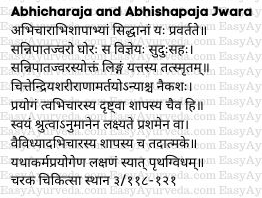
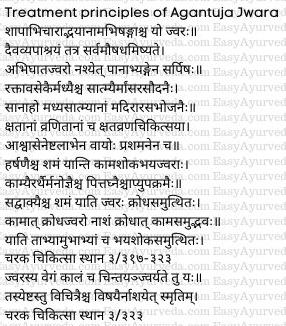
Read – Counselling – Types, Benefits, Myths And Facts
Treatment principles of Agantuja Jwara
Daiva vyapashraya chikitsa – Divine therapies are the first and best remedies for combating the fevers caused by curse, spells and evil forces.
Treatment for abhighataja jwara – Below mentioned measures should be considered for treating the fevers caused by injury.
- Sarpi pana – oral consumption of metered doses of ghee / medicated ghee
- Sarpi abhyanga – massage using ghee
- Raktavaseka – bloodletting
- Satmya madhya – consumption of compatible / likable wines to those who are used to consume wines
- Satmya mamsa odana – intake of compatible / likable foods with meat / meat soup to those who are used to take meat
- Kshata / Vrana Chikitsa – treatment on the lines of treating injuries and wounds shall be implemented
- Ashvasana – counseling and comforting words are ideal ways of treating fevers caused due to desire, grief and fear
- Ishta labha, vayu prashamana and harshana – providing desirous things, pacification of aggravated vata and therapies exhilarating and pleasing to the mind are beneficial in fevers caused due to desire, grief and fear
- Kamyaih arthaih manognaih cha, pittaghna upakramaih, sad vakyaih, – providing the desirous things, pitta mitigating measures and pleasing words are beneficial to combat fevers caused due to anger
- Viparita chikitsa – fevers caused due to desire get destroyed by manifestation of anger and fevers caused by anger are cured by manifestation of desire i.e. anger and desire are mutually antagonistic and destroy each other and hence the fevers caused by them. Similarly fevers caused by fear and grief are destroyed by desire and anger.
- Vismarana – In some people fever would manifest just by thinking about the timing of occurrence of fever. In these people a strong psychological component would be involved. It is important to diver the minds of these people and involve them in some other activity so that they forget the time of manifestation of fever. This will prevent the manifestation of fever in these people.
Sowmya and Agney Jwar
Sowmya jwara and Agneya Jwara are the types of fevers explained in Charaka Samhita in the context of Jwara Chikitsa i.e. chapter dealing with treatment of fevers. According to the word meaning –
- Sowmya Jvara means fevers which are cold or mild in nature.
- Agneya Jwara means fevers which are hot or severe in nature.
But do they actually mean the same? Let us explore the classical meanings of these fevers in this article.
Read – Jwara Pravritti – The Initial Manifestation

Manifestation of Sowmya and Agneya Jwara
In fevers which manifest due to vitiated vata and pitta, the person would feel desirous of cold comforts, including foods and activities. Cold comforts are the remedies for these fevers.
In fevers which manifest due to vitiated vata and kapha, the person would feel desirous of hot comforts, including foods and activities. Hot comforts are the remedies for these fevers. If we get combined fever wherein both these patterns get admixed, the person would feel desirous of both cold and hot comforts.
The above said is the classical explanation of sowmya and agneya jvara. Here we should observe that Master Charaka has not explained the nature of manifestation of fevers in these conditions. He has explained these two conditions from the perspective of what relieves these fevers. From this explanation we need to extract the exact meaning and pattern of manifestation of these two kinds of fevers.
Read – Typhoid In Ayurveda: Symptoms, Causes, Prognosis, Treatment
Sowmya Jwara – Vata, Kapha and Vata-Kapha fevers
The fever caused by vitiation of only vata or kapha are by nature ‘cold predominant’ and also caused by ‘cold causes’ (causative factors which induce coldness and increase vata or kapha as the case may be – includes foods and activities). This fever being cold and mild in nature (sowmya), the person shows desire towards hot things and comforts. Similar is the case of ‘vata-kaphaja’ fevers caused by combined vitiation of vata and kapha. Here both doshas are cold in nature and are also caused by causative factors which induce cold. Hence the person shows interest towards hot things and comforts.
Read – Continuous fever: Santata Jwara Pathogenesis, Treatment
Agneya Jwara – Pitta and Vata-Pitta fevers
The fever caused by vitiation of only pitta is by nature ‘heat predominant’ since pitta is hot in nature. This type of fever is also caused by ‘hot causes’ (causative factors which induce heat and increase pitta, included pitta aggravating foods and activities). This fever being hot and intense in nature, the person shows desire towards cold things and comforts. Vata-pittaja fever caused by combined aggravation of vata and pitta is a typical type of combination wherein vata is cold in nature and pitta is hot in nature. Then how is this fever agneya in nature?
Here vata, in its combination with pitta, seems to be showing an inclination towards the cold quality in spite of vata itself being cold. To clear the doubt that the same vata doesn’t behave in the same way when it is associated with kapha, master Charaka quotes in the next part of the verse ‘ushnam vata kaphatmakah’ i.e. vata here shows desire towards heat because it is associated with other cold element i.e. kapha.
Read – Charaka Jwara Nidana: 1st Chapter
Vata show different behaviors in combination with pitta and kapha?
Vata is extremely yogavahi in nature. When vata combines with pitta it behaves in accordance to the nature of pitta i.e. it owns and supports the heat. Just like the air passing through fire carries the heat of fire with it and we sense hot air touching us, vata in association with pitta is also hot in nature. Hence vata-pittaja fevers are hot in nature and show desire towards cold things. Therefore pittaja and vata-pittaja fevers are agneya jwaras.
When vata combines with kapha it behaves in accordance to the nature of kapha i.e. it owns and supports the cold. Just like the air passing through water carries the coldness of water with it and we sense cold air touching us, vata in association with kapha is also cold in nature. Hence vata-kaphaja fevers are cold in nature and show desire towards hot things. Therefore vataja, kaphaja and vata-kaphaja fevers are sowmya jwaras. This differential nature and behavior of vata with pitta and kapha is called as ‘yogavahitva’ of vata.
Read – Vata Dosha – Introduction, 40 Things To Know
Vyamishra Jwara
There are some fevers wherein we can get to combination of both these patterns of fevers. In these fevers there is a peculiar combination of agneya and sowmya jwaras. Herein the person would feel desirous for both cold and hot comforts. Since these fevers are neither purely agneya not purely sowmya, they belong to a different league of combined fevers and can be considered as vyamishra jwara. The causes for these fevers are also a mixture of hot and cold things. Example –
- Kapha-pittaja jwara – fevers caused due to combined aggravation of kapha and pitta
- Sannipataja jwara – fevers caused due to combined aggravation of all three doshas i.e. vata, pitta and kapha
Read – Vishama Jwara Definition, Causes, Types, Symptoms, Treatment
Sanskrit Verses
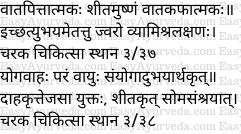
Shareerik, Manasik Jwar
Sharirika Jwara and Manasika Jwara are two types of fevers mentioned amongst the classification of fevers in Charaka Samhita Chikitsa Sthana in Jwara Chikitsa i.e. chapter 3 dealing with treatment of fever.
Sharira means body. By meaning Sharirika Jwara is that fever which manifests at the physical level. Manas means mind, thus Manasika Jwara is that fever which manifests at the mental level. Let us try to explore their meanings and the way in which these fevers are manifested.
Sharirika Jwara is that fever which first gets manifested at the physical level. Now this also means that this fever may, in later course can also afflict the mind and appear at the mental level. Manasika Jwara is that fever which first gets manifested at the mental level. Now this also means that this fever may, in later course can also afflict the body and manifest at the physical level.
Putting it briefly, both shareerika and manasika jvara can manifest at both physical and mental levels.
Read – Jwara Pravritti – The Initial Manifestation
What is the purpose of mentioning these two types of fever?
Master Chakrapani clarifies Master Charaka’s purpose of explaining these two fevers. Fevers either afflict the body or mind. In both cases the other one will be afflicted in the later period of time. This sums up to the understanding that ‘the body and the mind are the seats for all kinds of fevers’. Some fevers predominantly afflict the body and some afflict the mind predominantly.
Though it is clear that the fevers can either manifest at physical or mental planes, this classification is done from the ‘treatment perspective’. Understanding this classification properly would help the physician to plan the treatment of fevers in a comprehensive way. It is very important for the physician to understand whether the fever manifested first at the physical level or at the mental level. The patient would present with predominantly mental symptoms when he or she would report to the physician. But it may be a mental affliction of the physical fever. Here, in this case it is important to understand that the mental symptoms are secondary to the physical manifestation of fever. In this case the mental symptoms have appeared later and are probably feebler in comparison to the physical symptoms. The opposite picture is also true.
Shareerika Jwara is caused by severely aggravated physical doshas i.e. vata, pitta and kapha – in various combinations. These fevers shall be treated by expelling or pacifying the morbid physical doshas as per the strength of the disease and the diseased. Maanasika Jvara is caused by severely aggravated mental doshas i.e. rajas and tamas – in varying proportions. These fevers are treated by balancing the morbid mental doshas i.e rajas and tamas as per the strength of the disease and the diseased.
Read – Causes, Symptoms, Treatment Of Recurring Fevers Punaravartaka Jwara
Sanskrit Verses
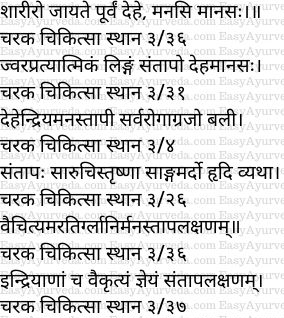
Read – Charaka Jwara Nidana: 1st Chapter
Diagnosis of Sharirika and Manasika jwaras
‘Santapah deha maanasah’ i.e. pain / discomfort in the body and mind have been mentioned as atma lakshana – mandatory sign of fever. (Cha.Chi.3/31)
Jwara is said to manifest with ‘deha indriya manah tapa’ i.e. pain or discomfort at the level of body, mind and sense organs. (Cha.Chi.3/4)
Putting these two references together fever can be described as a condition wherein there is santapa (pain, discomfort or severe rise in temperature) at the level of body, mind and senses. Fever can include one or all of these planes. But all planes will be eventually afflicted at some point if the fever is not treated comprehensively at proper time.
In brief, jwara is a combination of –
- Deha (dharira) santapa
- Manas santapa
- Indriya santapa
Read – Charaka – Jwara Chikitsa 3rd Chapter
Deha Santapa Lakshana
At the physical level santapa can be considered as ‘rise in physical temperature beyond normal proportions’. Pain and discomfort too shall be considered at physical level. The other symptoms mentioned along with santapa in the context of ‘jwara prabhava’ i.e. effect of fever i.e. anorexia (aruchi), thirst, pain in body parts (angamarda) and pain / discomfort in the region of the heart (hrdi vyatha) can also be found along with santapa. (Cha.Chi.3/26)
Manas Santapa Lakshana
Pain or discomfort at the mental level presents with the below mentioned symptoms –
- Vaichitya – mental confusion
- Arati – discontentment / regret / anxiety / languor / dullness / dissatisfaction / discontentment
- Glani – fatigue / sickness / depression / lassitude / exhaustion / brain-fog
Indriya Santapa Lakshana
Pain or discomfort at the level of sense organs is manifested in the form of indriya vaichitya i.e. failure of sense organs to perceive their sense objects.
Ama, Pachyamana And Nirama Jwara
Ama, pachyamana and nirama are three stages of fever. They can also be considered as three types of fever.
Are these fevers the stages or types?
Actually these three are the stages of the fever. This is because Master Charaka explains these three fevers after having explained the types of fever. He has not included these three fevers in the classification (jwara bheda) of fevers.
Pre context – Just before mentioning these fevers, Master Charaka has explained the pathogenesis of fever. We need to understand that all fevers going through the samprapti i.e. pathogenesis cycle will undergo through these three stages i.e. ama, pachyamana and nirama stages. This includes all fevers mentioned in the classification of fevers. Therefore ama, pachyamana and nirama jwaras are the stages of each and every type of fever.
Post context – Immediately after explaining these stages, Master Charaka mentions the contraindications for newly manifested fevers and immediately touches the ‘langhana and its benefits in the fever’ – which happens to be the first principle for the treatment of fevers, mainly those associated with ama (newly manifested fevers in their initial days of manifestation are associated with ama). The post-context i.e. treatment principles mentioned after the explanation of these stages also indicates that it is very important to understand these stages before beginning the treatment of fevers.
Read – Langhana Therapy – A Unique Ayurvedic Treatment Principle
Jwara, is a disease which gets its origin from amashaya i.e. stomach. In the initial days of the fever, ama is associated with the disease. All measures undertaken during the first 7-8 days of the fever will be to deal with and get rid of this ama. Therefore it is very important to know the status of ama in the fever and whether the fever is associated or dissociated with ama. Dissociation of ama doesn’t mean that the fever has reduced or gone away. It is just a stage free of ama and needs a different line of treatment. All these three stages of fever are identified and diagnosed on the basis of the signs and symptoms found at that stage
Sanskrit Verses
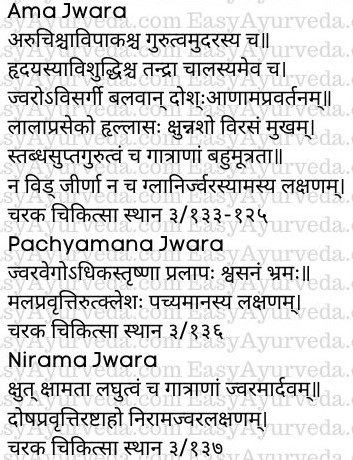
3 stages of fever
1. Ama Jwara
As the name indicates, this stage of fever is associated with ama. We can put it the other way and tell that the stage of fever wherein ama is associated in the disease is called as ama jwara. This is the first and intermediate stage of any kind of fever which is passing through the pathogenesis of fever.
Below mentioned are the signs and symptoms of ama jwara
- Aruchi – tastelessness
- Avipaka – indigestion
- Gurutvam udarasya – heaviness in the abdomen
- Hrudayasya avishuddhih – unpleasant feeling in the region of the heart (as if unclean, as if there are blocks)
- Tandra – sleepiness, stupor, drowsiness
- Alasya – laziness
- Avisargi – un-intermittent, fever is regular and ongoing
- Balavan – fever is strong in nature / severe fever
- Doshanam apravartanam – doshas are not expelled
- Lala praseka – excessive salivation
- Hrllasa – nausea
- Kshut nasha – destruction of hunger, loss of appetite
- Virasam mukham – bad and odd tastes in the mouth
- Stabdha gatrata – stiffness of the body
- Supta gatrata – numbness in the body parts
- Guru gatrata – heaviness in the body parts
- Bahu mutrata – excessive urination, polyurea
- Na vid jirna – feces associated with ama, unformed stools
- Na cha glani – no languor or lassitude (absence of exhaustion, fatigue, depression)
Read – Indigestion Causes, Symptoms, Treatment
2. Pachyamana Jwara
As the name indicates, this stage of fever is associated with ama which is in the process of getting digested. The ama association is there in the fever but not as severe as it was in the ama stage. Some portion of ama has been destroyed and digested and some portion of it remains and needs to be dealt with in the coming days. Digestion of ama has occurred due to the measures like langhana etc taken in the ama stage of fever. This is the second and intermediate stage of any kind of fever which is passing through the pathogenesis of fever.
Read – Jwara Langhana, Ghrita Prayoga
Below mentioned are the signs and symptoms of pachyamana jwara –
- Adhika jwara vega – intensity of the fever is severe (more severe than that in ama stage of fever)
- Adhika trshna – excessive thirst
- Pralapa – delirium
- Shvasanam – dyspnea / shortness of breath
- Bhrama – giddiness / vertigo
- Mala pravrtti – diarrhea
- Utklesha – nausea
3. Nirama Jwara
As the name indicates, this stage of fever is dissociated with ama or the ama is destroyed. Ama is destroyed or dissociated from the fever due to the ongoing treatment process. The residual ama which was present in the pachyamana stage of fever has been totally destroyed in this stage. In spite of ama being totally dealt with, this is not a disease-free stage. This means, the fever has not totally gone away, it is just dissociated and detached from its association with ama. The fever has reached a stage wherein further treatment in the form of medicines, therapies and diet can be administered until it is totally gone.
This is the third stage of any kind of fever which is passing through the pathogenesis of fever.
Read – Digestion Of Ama Associated With Doshas In Fever – Pachana In Jwara
Below mentioned are the signs and symptoms of nirama jwara –
- Kshut – feel of hunger
- Kshamata – thinning of the body, emaciation
- Laghutvam cha gatranam – lightness in the body / body parts
- Jwara mardavam – mildness of the fever, reduction of fever (intensity of fever)
- Dosha pravrutti – proper expulsion of doshas
- Ashtaha – eight days (passage of eight days from the day of onset of fever)
From the clinical perspective a thorough understanding of these three stages of fever is very important. This is because, as already discussed, these three stages would manifest in each and every type of fever.
The treatment principle for all these three stages is totally different. In fevers associated with ama, ama pachana measures and medicines should be used while the same interventions would not suit the stage of fever devoid of association of ama. This is because in this stage the ama would be absent and if ama digesting medicines are administered the patient would be harmed rather than being benefitted. Langhana vis-à-vis fasting or therapeutic starvation is ideal intervention in ama and pachyamana stages of fever. The same would worsen the fever when administered in the nirama stage. Similarly the measures administered in nirama stage should not be administered in ama stage.
Read – Use Of Herbal Decoctions In Fever -Kashaya In Jwara
Ashtaha or 8 days is the key component in understanding these stages. This is the upper limit of digestion of ama. Ama should get relieved from its association in the fever in or on the 8th day as a rule. When symptoms of nirama fever are manifested by 8th day it confirms that the fever is in nirama stage. When on 8th day if the other symptoms of nirama fever are not manifested and if some symptoms of ama or pachyamana fever are found, the fever shall not be considered as nirama. On the other hand if symptoms of nirama fever are manifested before 8 days, the fever shall be considered as nirama itself. So to consider a fever free from ama both – 8th day and the other symptoms mentioned in the context shall be considered, whichever manifests first. This concept is vital in understanding the dissociation of ama from the fever.
Click to Consult Dr Raghuram Y.S. MD (Ayu) – Skype








